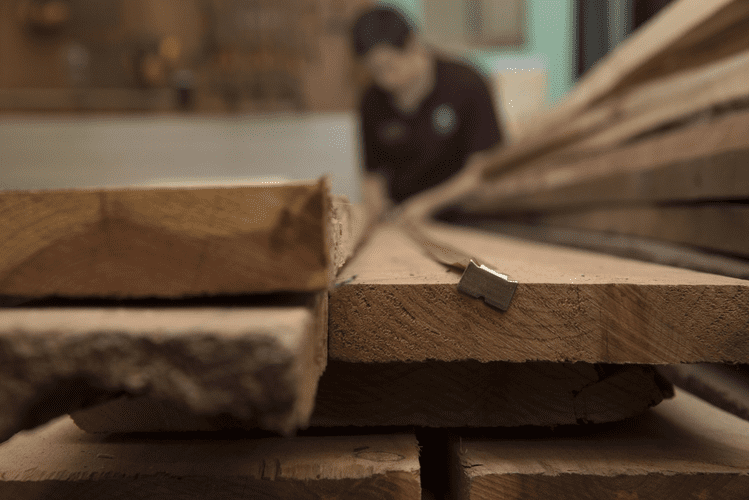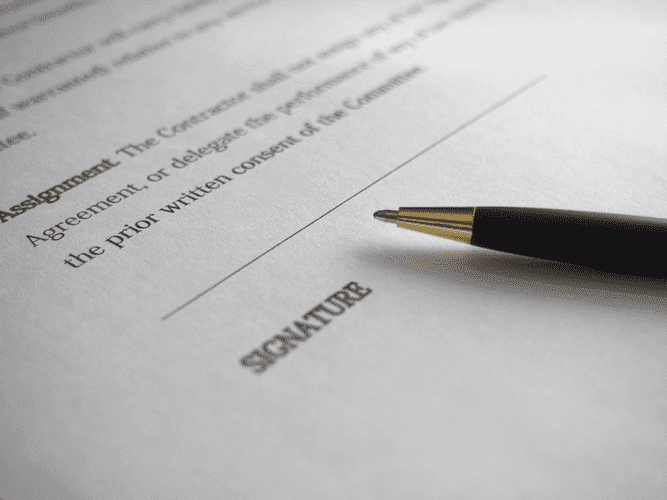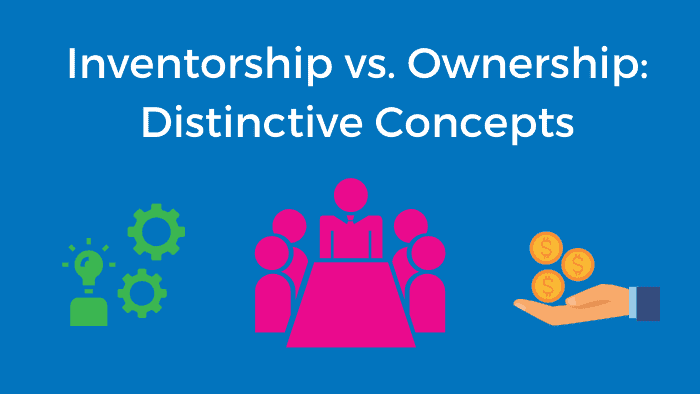A lot of times, a person or a team works on a project in a company and never see the money side of their creation.
If inventors are deemed special in the patent world, what are the rights of those researchers? How about the rights of the company or research facility? Who is the patent owner between the two? We will distinguish two concepts: inventorship and ownership in this article.
Inventorship in Patent Application – Who Is an Inventor?
What does it mean to be an inventor on a patent? In short, the question of inventorship is identifying who came up with th
e idea.
Ok, you probably could have guessed that, right?
U.S. patent law views an invention roughly as a two-step process:
- Conception
- Reduction to Practice
An idea is conceived, and the conceived idea is reduced to practice, i.e. a working example is made, or at least enough proof is presented that such a concept can be realized. Without any of these two, an invention is not patentable.
A quick note: reduction to practice can also mean an enabled invention. This means that you’ve written enough detail such that someone in the field could make it and put it to use. Note, the word “COULD”.
When determining who an inventor is, only the conception is relevant. If even a part of the eventually claimed subject matter came from you, then you are an inventor (or a co-inventor), and you must be named in the patent application.
Under U.S. law, an inventor is a person who took part in the conception of the idea in a patent application. But not everyone who contributes his or her conception to an invention becomes an inventor. The contributed conception must be important enough to be included in a claim of the patent.
The other refreshing thing to know is that each inventor must sign an oath/declaration stating that they are a rightful inventor and that all co-inventors have been named in the application to the best of their ability.
On top of that, each Patent Attorney that is representing one or more inventors, has a duty/obligation to list all co-inventors or face a malpractice claim or worse by defrauding the patent office.
A Wooden Chair Example:

An inventor comes up with a patent application for a wooden chair claiming new ergonomic arm rests.
She is not a carpenter, so she hires a carpenter to make a prototype chair, with detailed instructions about how the chair should be made.
The carpenter suggests to the inventor that a different kind of fastener commonly used in the industry should be used to secure the legs.
Is the carpenter a co-inventor?
In this case, the carpenter is not a co-inventor because the patent claim is not about fastening legs to a chair. The inventor can write in the specification of her patent application about how to fix the legs of a chair as suggested by the carpenter. But as long as it is not in a claim, the carpenter is not a co-inventor.
On the other hand, let’s say the carpenter’s assistant suggests another way of making ergonomic arm rests by increasing the radius of one of the center boards, and using a scroll saw between layers, and the inventor likes the idea. She then adds a claim to include the assistant’s idea. The assistant then becomes a co-inventor.
Once you are listed as an inventor of a patent, your name is engraved in the patent, as the name of an architect is engraved on the plaque of a building to commemorate the designer. But does the architect own the building? That, is a separate question.

Patent Ownership – Who Owns Patent Rights?
The question of ownership is the question of who can enforce the patent rights. Whoever enforces the rights, has the right to prevent others from making, using, and selling. Whoever has exclusionary rights has the ability to license and sell rights and…. MAKE MONEY!
So, if you follow who owns the patent, you will follow who eventually may make money from those rights.
Patent ownership, like any other form of intellectual property, is property. It is like the ownership of a house. An inventor can sell his/her patent ownership to somebody else, just like he/she sells his house. Once the ownership is sold, an inventor cannot enforce those patent rights to others. An inventor may also license the patent to a third party, similarly to leasing his house.
Here is an example of a patent document for US Patent 4,884,846 for a “Arm Chair…”. You can see in the Green circle, the “Inventor” “Peter Tobler” is named, but the Assignee is the “Equus Marketing Corp.” this is the “owner”

Under U.S. law, a patent owner has a right to exclude others from making, using, and selling his or her invention. So once an inventor transfers all his rights to a third party, the inventor cannot prohibit that third party from making, using, and selling the invention. Instead, the third party who purchased the rights now has those rights.
The relationship between inventorship and ownership is similar to an architect and a building owner. An architect designs a building, but a building owner has ownership of the building. The name of the architect is forever engraved on a plaque of the building. But unless the architect is also the building owner, the architect cannot use, sell or lease out the building, or evict its tenants.
Here is a brief summary of the ways in which a patent owner can exploit the patent rights:
- Preventing anyone else form making/using/selling and manufacturing and selling their own invention (this is the primary method)
- Licensing the ability to make, use, and/or sell (any one of them) to a 3rd party and being paid a lump sum or royalty based on revenue/sales/profits, etc.
- Suing for infringement in USPTO, Federal Court, ITC through litigation to achieve damages
Blog Article: How Much Does a Patent Cost?

Employer-Employee Situation
A tricky situation of inventorship and ownership often arises when an employee working for a company comes up with an idea.
Perhaps, that employee believes that the idea will be a big hit, the employee may want to quit their job to set up his or her own startup company.
If I asked you who the inventor was, you’d say, the employee of course. And you’d be right. But who is the patent owner?
More often than not, an employment agreement usually contains a provision that requires that for any IP created “as part of the job” is automatically assigned to the company!
Are you an employee? Take a break from this article and read your employment document, right now, and see for yourself. It’s usually called “IP Assignment” or “Patent Rights Assignment”. I’ll wait…
This clause means that if the invention was conceived “as a part of the job” it will be assigned to the company. Even if the employee’s name was engraved on the face of the patent, the inventor cannot enforce ownership rights.
Here are the big factors, (if true) weigh in favor of the company owning the IP rights:
- You used the company’s equipment and resources (computer, machinery, tools, etc.) to create/discover the invention
- You were “on the clock” and getting paid a wage/commission for creating the invention
- Your boss/supervisor asked you to come up with a solution, which was your invention
- Your invention is directly related to your job description
This is fair game for both the employee and the company, because often the employee’s invention is a byproduct of work at the company, or the invention was developed using the resources of the company.
Sometimes the employee is hired specifically to work on an invention. More importantly, the employment itself is part of the deal so that the employee receives a wage compensation for giving up intellectual property rights.

Of course, it would be absurd to require the employee to give up all rights even if the invention has nothing to do with the job. In that case, even if an assignment clause provided the employee to assign all rights created during the employment, the provision may be made unenforceable.
Many states differ in acknowledging the scope of enforceable assignment provisions. However, the bottom line for an employee is that once an employment agreement is signed, patent ownership may be gone if the invention has any bearing with his or her employment.
If any employees have ideas that they may want to file a patent application for in the future, it may be wise to disclose those ideas as their own at the time of employment, and put them in writing in the employment agreement, so if future conflicts do arise, there is no question as to who is the patent owner.
Now for an employer, what if you forgot to have your employee sign an employment agreement? Can you go after the employees who already quit, and make them sign a post-employment assignment?
That may not be very easy. It is because you are now asking your former employee to give up his or her own rights, while you do not give anything in return. In this case, the company may claim its rights to the former employee’s patents, depending on the character of the employment.
This point is pure contract law, which requires there be a consideration on both sides of the contract. Meaning, there has to be something the employee is gaining by agreeing to be bound to additional restrictions on their rights…so, yes, you guessed it – you would have to financially compensate them for agreeing to assign all of their IP if you forgot to in your initial employment contract.
If the employment was of a typical employer-employee relationship, and the invention is within the scope of employment, then the company may have ownership. If, on the other hand, the employment was more like hiring an independent contractor, where the employee had control over what to do to complete the job, the employee may have ownership. If the employment was made specifically to work on an invention, the company may have ownership.
As it is the case with most legal issues, each of these considerations is fact-specific, and it is better for both parties to avoid ambiguity by putting things in writing in advance. Therefore, it is crucial for an employer to clear the intellectual property rights assignment issue at the time of employment before it is too late or grows into a headache.
- Blog Article: Can Multiple People Own a Patent?
- Blog Article: Work for Hire Agreements
Conclusion
To recap here is what I covered in our inventorship and ownership article.
- Inventorship: Who should be named?
- Patent Ownership: Who has the rights?
- Employee and Employer Relationship
I hope the topics covered provided you with the information you were looking for regarding inventorship and ownership. Do you have more specific question in mind?
Book a free consultation today!

